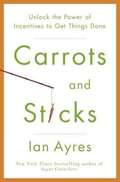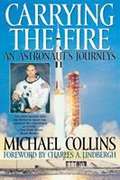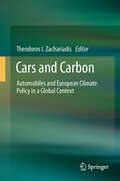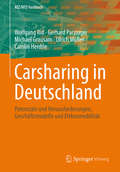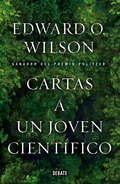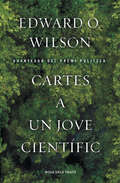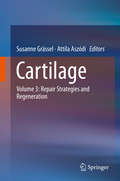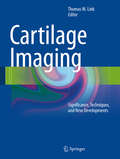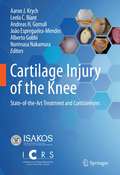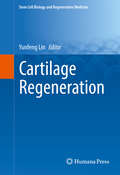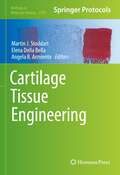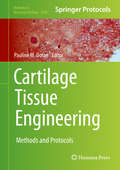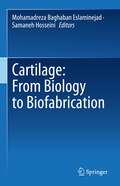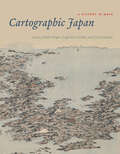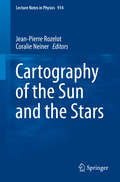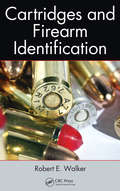- Table View
- List View
Carrots and Sticks: Unlock the Power of Incentives to Get Things Done
by Ian AyresCould you lose weight if you put $20,000 at risk? Would you finally set up your billing software if it meant that your favorite charity would earn a new contribution? If you've ever tried to meet a goal and came up short, the problem may not have been that the goal was too difficult or that you lacked the discipline to succeed. From giving up cigarettes to increasing your productivity at work, you may simply have neglected to give yourself the proper incentives. In Carrot and Sticks, Ian Ayres, the New York Times bestselling author of Super Crunchers, applies the lessons learned from behavioral economics--the fascinating new science of rewards and punishments--to introduce readers to the concept of "commitment contracts": an easy but high-powered strategy for setting and achieving goals already in use by successful companies and individuals across America. As co-founder of the website stickK.com (where people have entered into their own "commitment contracts" and collectively put more than $3 million on the line), Ayres has developed contracts--including the one he honored with himself to lose more than twenty pounds in one year--that have already helped many find the best way to help themselves at work or home. Now he reveals the strategies that can give you the impetus to meet your personal and professional goals, including how to * motivate your employees* create a monthly budget * set and meet deadlines * improve your diet* learn a foreign language* finish a report or project you've been putting off* clear your desk Ayres shares engaging, often astounding, real-life stories that show the carrot-and-stick principle in action, from the compulsive sneezer who needed a "stick" (the potential loss of $50 per week to a charity he didn't like) to those who need a carrot with their stick (the New York Times columnist who quit smoking by pledging a friend $5,000 per smoke . . . if she would do the same for him). You'll learn why you might want to hire a "professional nagger" whom you'll do anything to avoid--no, your spouse won't do!--and how you can "hand-tie" your future self to accomplish what you want done now. You'll find out how a New Zealand ad exec successfully "sold his smoking addiction," and why Zappos offered new employees $2,000 to quit cigarettes. As fascinating as it is practical, as much about human behavior as about how to change it, Carrots and Sticks is sure to be one of the most talked-about books of the year.From the Hardcover edition.
Carrying The Fire: An Astronaut's Journeys
by Michael Collins Charles A. LindberghNASA astronaut Michael Collins trained as an experimental test pilot before venturing into space as a vital member of the Gemini 10 and Apollo 11 missions. In Carrying the Fire, his account of his voyages into space and the years of training that led up to them, Collins reveals the human tensions, the physical realities, and the personal emotions surrounding the early years of the space race. Collins provides readers with an insider's view of the space program and conveys the excitement and wonder of his journey to the moon. As skilled at writing as he is at piloting a spacecraft, Collins explains the clash of personalities at NASA and technical aspects of flight with clear, engaging prose, withholding nothing in his candid assessments of fellow astronauts Neil Armstrong, John Glenn, and Buzz Aldrin, and officials within NASA. A fascinating memoir of mankind's greatest journey told in familiar, human terms, Carrying the Fire is by turns thrilling, humorous, and thought-provoking, a unique work by a remarkable man.
Cars On Mars: Roving The Red Planet
by Alexandra SiyIn CARS ON MARS readers can follow the course of NASA's Mars Exploration Rover (MER) mission as twin rovers Spirit and Opportunity explore the Red Planet. Learn how scientists determined that there was once water on Mars and how the Earthbound NASA team resolved problems with the rovers from afar in order to prolong the mission, which continues today. The author provides insight into scientists' quest to discover whether life may have or still might exist on Mars. Back matter includes glossary, source notes, and resources.
Cars and Carbon: Automobiles and European Climate Policy in a Global Context
by Theodoros I. ZachariadisThis volume contains articles from leading analysts and researchers on sustainable transportation, who provide critical reflections on how automobile-related climate policies have evolved up to now in Europe and around the world, in view of the widely recognized need to substantially curb global emissions of greenhouse gases in the coming decades. Authors describe the policies which have been most effective, outline their economic and social implications, present success stories while critically reviewing less successful examples, and suggest strategies to decarbonize passenger transportation on a global scale.
Carsharing in Deutschland: Potenziale und Herausforderungen, Geschäftsmodelle und Elektromobilität (ATZ/MTZ-Fachbuch)
by Ulrich Müller Wolfgang Rid Gerhard Parzinger Michael Grausam Carolin HerdtleSowohl die Elektromobilit#65533;t als auch Carsharing-Konzepte besitzen hohe Bedeutung im Rahmen nachhaltiger Mobilit#65533;tskonzepte und der Energiewende in Deutschland. Daher lohnt sich ein Blick auf die aktuelle Situation, die Potenziale und die Erfolgsfaktoren bez#65533;glich des Einsatzes von Elektrofahrzeugen in Carsharing-Angeboten. Wo steht das Carsharing-Prinzip heute und welche Voraussetzungen bietet es f#65533;r den Einsatz von Elektrofahrzeugen: Wie kann durch Carsharing und der Einsatz von Elektrofahrzeugen im Carsharing die Entwicklung neuer Mobilit#65533;tsformen vorangebracht werden, was sind die Betreiber- und Gesch#65533;ftsmodelle? Welche m#65533;glichen H#65533;rden m#65533;ssen dabei #65533;berwunden werden, wann ist Carsharing wirtschaftlich und was sind weitere zentrale Erfolgsfaktoren f#65533;r eCarsharing in Deutschland?
Cartas a un joven científico
by Edward O. WilsonLos sabios y apasionados consejos de E.O. Wilson a las nuevas generaciones de científicosQuerido amigo:Después de medio siglo de enseñar a estudiantes y a jóvenes profesionales de la ciencia, he tenido el privilegio y la suerte de haber aconsejado a muchos cientos de jóvenes de talento y ambiciosos. Como resultado, he acumulado un conocimiento profundo, una filosofía, en realidad, de lo que es necesario saber para tener éxito en el ámbito de la ciencia. Espero que puedas sacar provecho de los pensamientos y relatos que te ofreceré a lo largo de las cartas que siguen.Ante todo, y muy importante, te exhorto a permanecer en el camino que has escogido y a seguirlo tan lejos como te sea posible. El mundo te necesita, y mucho.Edmund O. Wilson«Inspirador... Debería estar en las estanterías de todos los institutos y bibliotecas.»Library Journal«Quiero expresar mi agradecimiento. Gracias por recordarme, a mí y a otros miles, por qué nos convertimos en científicos.»Bill Stevens, The New York Times Book ReviewEdward O. Wilson aconseja a los investigadores presentes y futuros, y comparte su sabiduría con las nuevas generaciones de científicos. Lo hace a través de anécdotas autobiográficas que han forjado su carrera como científico, sus éxitos y sus fracasos, animado por la motivación que lo ha llevado a convertirse en uno de los biólogos más importantes del mundo.En este momento de la historia de la humanidad en el que nuestra supervivencia está más vinculada que nunca a los conocimientos científicos, Wilson insiste en que el talento no reside en la inteligencia matemática, sino en la pasión por plantear un problema y saber resolverlo. Desde la colisión de las estrellas hasta la exploración de los bosques tropicales y las profundidades de los océanos, Wilson infunde en sus lectores el amor por la creatividad científica y elrespeto por el humilde lugar que ocupa el ser humano en el ecosistema del planeta. Un libro para científicos, jóvenes y no tan jóvenes, sobre la pasión y el placer por el descubrimiento.
Cartes a un jove científic
by Edward O. Wilson JOAN- ROS ARAGONESEls savis i apassionats consells d'E.O. Wilson a les noves generacions de científics. «Benvolgut amic:Al cap de mig segle d'ensenyar estudiants i joves professionals de l'àmbit de la ciència, he tingut el privilegi i la sort d'haver aconsellat centenars de joves ambiciosos i de gran talent. De resultes d'això, he adquirit un coneixement profund, una filosofia, en realitat, d'allò que cal saber per tenir èxit en el terreny de la ciència. Espero que treguis profit dels pensaments i els relats que t'ofereixo al llarg de les cartes que llegiràs tot seguit. En primer lloc, i molt important, t'exhorto a perseverar en el camí que has escollit i a seguir-lo fins tan lluny com et sigui possible anar. El món et necessita, i molt.»Edmund O. Wilson Opinió:«Inspirador... Hauria d'estar als prestatges de tots els instituts i biblioteques.»Library Journal
Cartilage
by Susanne Grässel Attila AszódiIn three Volumes this mini book series presents current knowledge and new perspectives on cartilage as a specialized yet versatile tissue. This third volume provides insight into current and future treatment strategies for repair of cartilage lesions. This book addresses Professors, researchers and PhD students who are interested in musculoskeletal and cartilage pathobiology and tissue-engineering.
Cartilage Imaging: Significance, Techniques, and New Developments
by Thomas M. LinkThis authoritative book provides state-of-the-art practices and new developments in the imaging of cartilage, associated pathologies, and repair procedures. With a main focus on MRI, major advances in cartilage imaging are put into clinical context relevant for radiologists, rheumatologists, and orthopedic surgeons. International experts provide their insights on cartilage pathologies associated with such conditions as osteoarthritis, osteochondral trauma, and cartilage repair. Morphological MRI techniques are outlined, including new sequences and high field imaging. Molecular imaging techniques able to characterize the biochemical composition of the cartilage matrix are discussed, such as T2 relaxation time, T1rho, and dGEMRIC methods. The first book of its kind, Cartilage Imaging: Significance, Techniques, and New Developments encompasses the full scope of knowledge in this rapidly evolving field. Identifying key techniques for characterizing disease processes as well as objectively and quantitatively evaluating the results of therapy, this outstanding resource is of benefit to all physicians interested in assessing cartilage disease and repair.
Cartilage Injury of the Knee: State-of-the-Art Treatment and Controversies
by Alberto Gobbi João Espregueira-Mendes Norimasa Nakamura Andreas H. Gomoll Aaron J. Krych Leela C. BiantCartilage injuries of the knee are common, and diagnosis and treatment options have continued to evolve. This book focuses on current non-operative and surgical treatment strategies for articular cartilage injuries, highlighting the controversies and different approaches from an international perspective. This book includes information on the basic science of cartilage structure and function, expert perspectives on imaging and diagnosing, as well as work-up of athletes and patients presenting with acute or chronic cartilage injury. It also provides an evidence base for current cutting-edge cartilage repair and restoration. Written by leading experts in the field, the book, published in collaboration with ISAKOS and ICRS, is vital reading for orthopaedic and sports medicine surgeons, fellows and residents. It is also of interest to sports trainers, physiotherapists, medical students, postgraduate students, and physical medicine and rehabilitation specialists.
Cartilage Regeneration (Stem Cell Biology and Regenerative Medicine)
by Yunfeng LinThis book focuses on cartilage defects and new mesenchymal stem cell-based treatments for their repair and regeneration. Early chapters provide a review of current etiological findings and repair methods of cartilage defects. The next chapters discuss fundamental concepts and features of MSCs, including their proliferation, differentiation, migration and immunomodulatory effects. The discussion also includes clinical applications of MSCs in cartilage tissues, especially with regards to various animal models, biomaterials and transferring techniques. Cartilage Regeneration focuses on the biology of MSCs and their possible applications in cartilage reconstruction, with the goal of bringing new insights into regenerative medicine. It will be essential reading for researchers and clinicians in stem cells, regenerative medicine, biomedical engineering and orthopedic surgery.
Cartilage Tissue Engineering (Methods in Molecular Biology #2598)
by Martin J. Stoddart Elena Della Bella Angela R. ArmientoThis detailed book brings together a collection of methodologies, from the most basic to the more complex, that provides researchers with a platform they can use to embark on a cartilage research career. To aid in the search for novel therapies for cartilage regeneration, this volume addresses 3D cartilage models, challenges associated with RNA and protein extraction, imaging, gene transfer, as well as stable differentiation and variations in cell phenotype from different tissue origins. Written for the highly successful Methods in Molecular Biology series, chapters include introductions to their respective topics, lists of the necessary materials and reagents, step-by-step and readily reproducible laboratory protocols, and tips on troubleshooting and avoiding known pitfalls. Authoritative and up-to-date, Cartilage Tissue Engineering serves as an ideal guide for researchers working to advance the vital study of cartilage biology and repair.
Cartilage Tissue Engineering: Methods and Protocols (Methods in Molecular Biology #1340)
by Pauline M. DoranThis volume aims to describe clearly and in detail the key practical skills involved in cartilage tissue engineering. Methods are outlined for isolation and expansion of chondrocytes and stem cells; differentiation; synthesis and application of three-dimensional scaffolds; design and operation of bioreactors; in vivo testing of engineered constructs; and molecular and functional analysis of cartilage cells and tissues. Frequently used technologies are covered, as well as more recent advances in inspirational areas such as 'smart' biomaterial development, novel bioreactor design, -omics analysis, and genetic manipulation of matrix synthesis. The key procedures discussed either underpin the progress already achieved in cartilage tissue engineering or are indicative of the direction of future research in the area. Written in the highly successful Methods in Molecular Biology series format, chapters include introductions to their respective topics, lists of the necessary materials and reagents, readily reproducible step-by-step laboratory protocols, and tips on troubleshooting and avoiding known pitfalls. Authoritative and cutting-edge, Cartilage Tissue Engineering: Methods and Protocols is a useful resource that informs the scientific community about the experimental work covering a broad range of objectives for cartilage synthesis and regeneration.
Cartilage: From Biology to Biofabrication
by Mohamadreza Baghaban Eslaminejad Samaneh HosseiniThis book provides a comprehensive overview of cartilage structure, functions, and approaches for the regeneration of cartilage tissue. It reviews multiple signaling pathways that are involved in the growth and repair of cartilage tissue. The initial chapter of the book examines the etiology, diagnosis, and pathological features of various cartilage diseases. Subsequently, the book presents recent advances in biomaterial sciences, regenerative medicine, and fabrication technology for cartilage regeneration. It discusses hydrogels as a promising scaffold for cartilage tissue engineering, focusing on recapitulating microenvironments present during development or in adult tissue to induce the formation of cartilaginous constructs with biochemical and mechanical properties of native tissue. Lastly, it covers the applications of 3 D printing techniques for the fabrication of scaffolds for cartilage tissue regeneration for the production of biological implants capable of treating a range of conditions.
Cartographic Japan: A History in Maps
by Kären Wigen Sugimoto Fumiko Cary KaracasMiles of shelf space in contemporary Japanese bookstores and libraries are devoted to travel guides, walking maps, and topical atlases. Young Japanese children are taught how to properly map their classrooms and schoolgrounds. Elderly retirees pore over old castle plans and village cadasters. Pioneering surveyors are featured in popular television shows, and avid collectors covet exquisite scrolls depicting sea and land routes. Today, Japanese people are zealous producers and consumers of cartography, and maps are an integral part of daily life. But this was not always the case: a thousand years ago, maps were solely a privilege of the ruling elite in Japan. Only in the past four hundred years has Japanese cartography truly taken off, and between the dawn of Japan's cartographic explosion and today, the nation's society and landscape have undergone major transformations. At every point, maps have documented those monumental changes. Cartographic Japan offers a rich introduction to the resulting treasure trove, with close analysis of one hundred maps from the late 1500s to the present day, each one treated as a distinctive window onto Japan's tumultuous history. Forty-seven distinguished contributors--hailing from Japan, North America, Europe, and Australia--uncover the meanings behind a key selection of these maps, situating them in historical context and explaining how they were made, read, and used at the time. With more than one hundred gorgeous full-color illustrations, Cartographic Japan offers an enlightening tour of Japan's magnificent cartographic archive.
Cartography of the Sun and the Stars (Lecture Notes in Physics #914)
by Coralie Neiner Jean-Pierre RozelotThe mapping of the surface of stars requires diverse skills, analysis techniques and advanced modeling, i. e. the collaboration of scientists in various specialties. This volume gives insights into new techniques allowing for the first time to obtain resolved images of stars. It takes stock of what has been achieved so far in Chile, on the ESO VLTI instrument or, in the States, on the CHARA instrument. In recent times interferometry, combined with adaptive optics has allowed to reconstruct images of stars. Besides the Sun (of course) by now five stars have been resolved in detail. In addition to interferometry, this book highlights techniques used for mapping the surfaces of stars using photometry made by space observatories; Zeeman- and Doppler Imaging; mapping the surface element abundances via spectroscopy. This book will also take stock of the best images of the solar surface, made by connecting the differential rotation to the underlying physical parameters derived from helioseismology. Recent measurements of flattening of the solar surface by SDO showed that the Sun's shape is linked to the rotation of the core. It is shown how such a result is generalizable to the stars.
Cartridges and Firearm Identification
by Robert E. WalkerAt a time when crime scene television shows are all the rage amongst the civilian population, knowledge of firearm forensics is of paramount importance to crime scene analysts, police detectives, and attorneys for both the prosecution and the defense. Cartridges and Firearm Identification brings together a unique, multidisciplined approach to quest
Carver: A Life in Poems
by Marilyn NelsonGeorge Washington Carver was born a slave in Missouri about 1864 and was raised by the childless white couple who had owned his mother. In 1877 he left home in search of an education, eventually earning a master's degree. In 1896, Booker T. Washington invited Carver to start the agricultural department at the all-black-staffed Tuskegee Institute, where he spent the rest of his life seeking solutions to the poverty among landless black farmers by developing new uses for soil-replenishing crops such as peanuts, cowpeas, and sweet potatoes. Carver's achievements as a botanist and inventor were balanced by his gifts as a painter, musician, and teacher. This Newbery Honor Book and Coretta Scott King Author Honor Book by Marilyn Nelson provides a compelling and revealing portrait of Carver's complex, richly interior, profoundly devout life.
Carving Our Destiny: Scientific Research Faces A New Millennium
by National Research CouncilThis is a book for people who love and understand science and want to know more about contemporary research frontiers. The questions addressed are as fascinating as they are diverse: Is the human mind truly unique among the primates?<P><P> Does "dark matter" really exist in the universe? What can the human genome tell us about our evolutionary history?These wide-ranging topics are brought together by virtue of their impact on our understanding of ourselves--and by the caliber of the authors: ten young scientists and scholars, reaching the height of their powers, who are especially talented in communicating their research findings to broad audiences. They were chosen to receive the prestigious Centennial Fellowships awarded in 1998 by the McDonnell Foundation, established and funded by the late aerospace pioneer James S. McDonnell.
Cascade Biocatalysis Integrating Stereoselective and Environmentally Friendly Reactions
by Sergio Riva Wolf-Dieter FessnerThis ready reference presents environmentally friendly and stereoselective methods of modern biocatalysis. The experienced and renowned team of editors have gathered top international authors for this book. They cover such emerging topics as chemoenzymatic methods and multistep enzymatic reactions, while showing how these novel methods and concepts can be used for practical applications. Multidisciplinary topics, including directed evolution, dynamic kinetic resolution, and continuous-flow methodology are also discussed. From the contents: * Directed Evolution of Ligninolytic Oxidoreductases: from Functional Expression to Stabilization and Beyond * New Trends in the In Situ Enzymatic Recycling of NAD(P)(H) Cofactors * Monooxygenase-Catalyzed Redox Cascade Biotransformations * Biocatalytic Redox Cascades Involving w-Transaminases * Multi-Enzyme Systems and Cascade Reactions Involving Cytochrome P450 Monooxygenases * Chemo-Enzymatic Cascade Reactions for the Synthesis of Glycoconjugates * Synergies of Chemistry and Biochemistry for the Production of Beta-Amino Acids * Racemizable Acyl Donors for Enzymatic Dynamic Kinetic Resolution * Stereoselective Hydrolase-Catalyzed Processes in Continuous-Flow Mode * Perspectives on Multienzyme Process Technology * Nitrile Converting Enzymes Involved in Natural and Synthetic Cascade Reactions * Mining Genomes for Nitrilases * Key-Study on the Kinetic Aspects of the In-Situ NHase/AMase Cascade System of M. imperiale Resting Cells for Nitrile Bioconversion * Enzymatic Stereoselective Synthesis of Beta-Amino Acids * New Applications of Transketolase: Cascade Reactions for Assay Development * Aldolases as Catalyst for the Synthesis of Carbohydrates and Analogs * Enzymatic Generation of Sialoconjugate Diversity * Methyltransferases in Biocatalysis * Chemoenzymatic Multistep One-Pot Processes
Cascaded Interferometers and Their Medical Applications (SpringerBriefs in Applied Sciences and Technology)
by Abdallah HamedThis book looks at the application of cascaded interferometers in both theoretical and practical contexts, particularly focusing on enhancing image contrast and facilitating medical diagnostics. Commencing with a comprehensive exploration of modulated two-beam interference employing Fourier optics, it progresses to discuss the implementation of a cascaded Michelson interferometer, with a specialized emphasis on its utility in analyzing microscopic structures such as glass fibers. Subsequent chapters examine step-index fibers using multiple laser beam interferometry and introduce sophisticated models for interpreting fringe shifts in unclad glass fibers through ordinary multiple-beam interference. Moreover, the book addresses the recognition of modulated apertures employing a Cascaded Fabry-Perot Interferometer (CFPI) and discusses its implications for various applications. It looks at the processing of retinal artery images leveraging higher orders of two-beam interference and investigates the utility of cascaded interferometric techniques in examining kidney and colon images. Furthermore, it presents a novel approach to image processing of coronaviruses utilizing interferometry techniques, showcasing the potential of interferometric methods in medical research and diagnostics. Through its systematic exploration of cascaded interferometers and their diverse applications, this book is suited for researchers, practitioners, and students alike, offering insights into both fundamental principles and advanced methodologies in interferometry and medical imaging.
Cascadia's Fault: The Earthquake and Tsunami That Could Devastate North America
by Simon Winchester Jerry ThompsonThere's a crack in the earth's crust that runs roughly 31 miles offshore, approximately 683 miles from northern California up through Vancouver Island off the coast of British Columbia. The Cascadia Subduction Zone has generated massive earthquakes over and over again throughout geologic time-at least 36 major events in the last 10,000 years. This fault generates a monster earthquake about every 500 years. And the monster is due to return at any time. It could happen 200 years from now, or it could be tonight. The Cascadia Subduction Zone is virtually identical to the offshore fault that wrecked Sumatra in 2004. It will generate the same earthquake we saw in Sumatra, at magnitude 9 or higher, sending crippling shockwaves across a far wider area than any California quake. Slamming into Sacramento, Portland, Seattle, Victoria, and Vancouver, it will send tidal waves to the shores of Australia, New Zealand, and Japan, damaging the economies of the Pacific Rim countries and their trading partners for years to come. In light of recent massive quakes in Haiti, Chile, and Mexico, Cascadia's Fault not only tells the story of this potentially devastating earthquake and the tsunamis it will spawn, it also warns us about the impending crisis almost unprecedented in modern history.
Case Against Vaccine Mandates
by Kent HeckenlivelyKent Heckenlively, New York Times bestselling author of Plague of Corruption, calls upon both common sense and legal precedence to fight against vaccine mandates around the country. "My body, my choice!" used to be the rallying cry of the left in the abortion fight. But now this same principle of bodily autonomy is the central argument of conservatives, such as that of Florida Governor Ron DeSantis in fierce opposition to so-called "vaccine passports," which would limit whether an individual could attend movies or other public events, work, or even go to school, if they chose to decline a COVID-19 vaccine. While cities like New York close their doors to unvaccinated people, the fight against vaccine mandates is cobbling together an unexpected alliance across the political spectrum, such as the Black mayor of Boston, Kim Janey, who recently claimed, "there's a long history" in this country of people "needing to show their papers" and declaring any such passport as akin to slavery. The starting point agreed upon by all parties as to whether the government can bring such pressure to bear upon individuals is the 1905 US Supreme Court of Jacobson v. Massachusetts. In that case, a Lutheran pastor declined a smallpox vaccination and was fined $5, the equivalent of a little more than $150 in today's currency, or less than many traffic tickets. The Jacobson case sparked a shameful legacy in American jurisprudence, being used as the sole reasoning by the US Supreme Court to allow the forced sterilization of a female psychiatric patient in 1927. This ruling paved the way for the involuntary sterilization of more than sixty thousand mental patients and gave legal justification to the eugenics movement, one of the darkest chapters in American medicine. In The Case Against Vaccine Mandates, New York Times bestselling author Kent Heckenlively, whose books have courageously taken on Big Pharma, Google, and Facebook, now points his razor sharp legal and literary skills against vaccine passports and mandates, which he believes to be the defining issue as to whether we continue to exist as a free and independent people.
Case Studies for Advances in Paleoimaging and Other Non-Clinical Applications
by Ronald G. Beckett Gerald J. Conlogue Andrew NelsonThe case studies provided in Case Studies for Advances in Paleoimaging will provide the reader with real-world scenarios and case examples that will help prepare researchers to discover new ways to apply the various modalities associated with the technology. This book is a follow-up to the Beckett and Conlogue’s classic work Paleoimaging (2009) and companion to their new contribution Advances in Paleoimaging (2020). The case studies outlined demonstrate the problem-solving nature of imaging research and the application of critical thought to unique problems. Further, Case Studies for Advances in Paleoimaging demonstrates the incredible depth of application of these modalities including photography, endoscopy, x-ray fluorescence, plane radiography, digital radiography, and advanced imaging modalities like multi-detector computed tomography, micro-computed tomography, and magnetic resonance imaging. Of particular note, case study seven, Contrast Media Injections, informs the researcher regarding methods to bring out specific anatomic structures that may be the target of a given research question. Intended for students, faculty, and seasoned researchers, Case Studies for Advances in Paleoimaging presents actual cases from the authors’ vast experience in the application of paleoimaging modalities in order to answer unique research problems. The book also serves as a field manual for current and future researchers as they approach similar or new cases that present unique challenges. These cases demonstrate how the varied imaging methodologies can provide data which greatly enriches our understanding of the subject at hand, be it ancient cultural remains, forensic recovery, museum holdings, or other anthropological and archaeological artifacts.
Case Studies in Systems Biology
by Pavel KraikivskiThis book provides case studies that can be used in Systems Biology related classes. Each case study has the same structure which answers the following questions: What is the biological problem and why is it interesting? What are the relevant details with regard to cell physiology and molecular mechanisms? How are the details put together into a mathematical model? How is the model analyzed and simulated? What are the results of the model? How do they compare to the known facts of the cell physiology? Does the model make predictions? What can be done to extend the model? The book presents a summary of results and references to more relevant sources.The volume contains the classic collection of topics and studies that are well established yet novel in the systems biology field.
